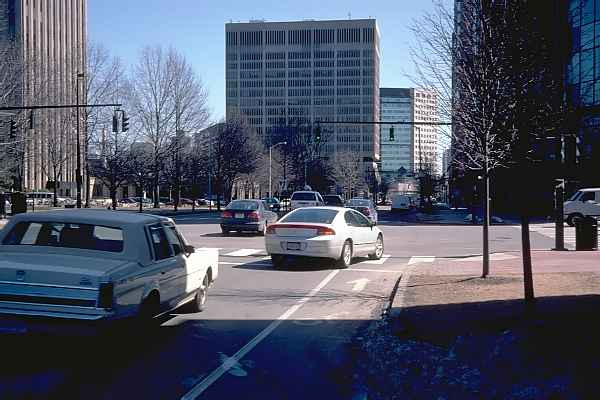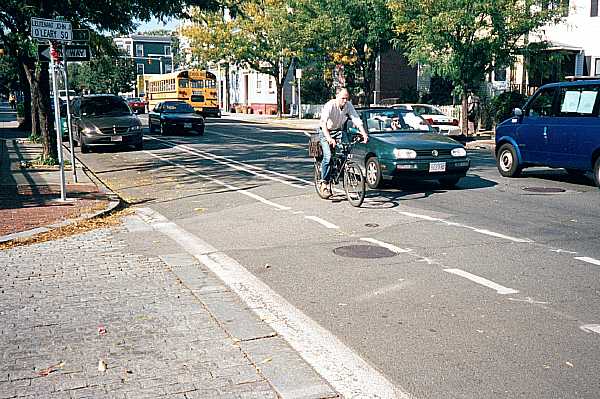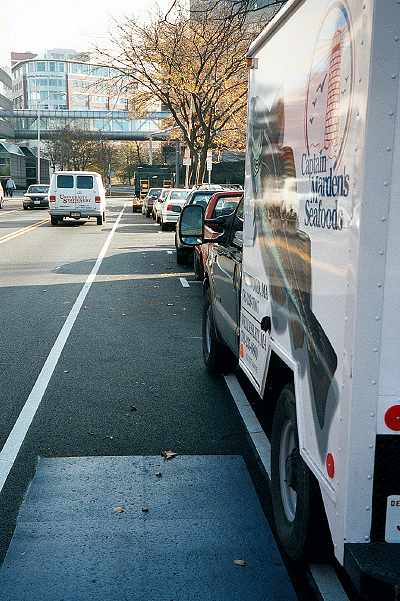
Top: Home Page
Up: Cambridge bicycle facilities and program
CAMBRIDGE: GENERAL COMMENTS ON BIKE LANESI agree with many of the bicycle-related measures Cambridge has taken, particularly, educational and law-enforcement measures. I have found bicycle coordinator Cara Seiderman to be an effective proponent of bicycle-related programs within the Cambridge city government. However, Seiderman did graduate study in Denmark, and came to her position in Cambridge with a vision of bicycling formed by that experience. I disagree with Seiderman about the validity of the Northern European vision of bicycle facilities, and about its implementations in Cambridge. On major streets, Danish cities have special bike lanes, separate from those for motor vehicles, at the edge of the street. Motorists turning or right across the bike lanes must not merge into the bike lane, but instead must yield before crossing the bike lane. Unlike the American approach in which bicyclists may make left turns either as vehicle operators or according to pedestrian rules, Danish traffic law prohibits bicyclists from making vehicular left turns at major intersections. Or to put it in the simplest terms, in Denmark, bicyclists are required to turn left from the right lane, and motorists are required to turn right from the left lane. Motorists must, then, yield to bicyclists in their right rear blindspot, a maneuver which imposes additional delay and/or danger. Bicyclists may not merge to the vehicular left turn position, but must cross all of the traffic lanes at once like a pedestrian, a maneuver which has the same problems and is also much slower than a vehicular left turn. In my days on the Cambridge Bicycle Committee, I had a discussion with Seiderman about a draft of an instructional pamphlet that indicated that motorists should yield to bicyclists in the bike lane, but without indicating how or when. I pointed out to her that American traffic law requires drivers making a right turn to merge into the right lane first, even if it is a bike lane. Seiderman was visibly uncomfortable with my comment. Seiderman's underlying assumption appears to be that motorists should defer to bicyclists -- that bicyclists should have a special status which she regards as superior to that of motorists, able to use the streets while maneuvering more like pedestrians than like vehicle operators. If right-turning motorists must cross the bike lane the way they cross a sidewalk, then bicyclists are supposedly protected in the same way as pedestrians. Problem is, the special status may reflect a sense of moral and environmental superiority, but it is inferior in terms of safety. A motorist can not reliably yield to a bicyclist overtaking on the right at 10 to 20 miles per hour. Three bicyclists have died between 1999 and 2002 in the Boston area while attempting to overtake on the right. There has also been a very serious and widely publicized bicycle/pedestrian collision in which the bicyclist was overtaking a motorist on the right. In its first bike lane installations on Mt. Auburn Street and Massachusetts Avenue, Cambridge bowed to the requirements of research and of the traffic law to the extent of dashing the lane stripe before major intersections to indicate that motorists should merge into the bike lane. The stripes were not very convincing. They were so short that they were not visible from half a block away. The dashed length of bike lane was too short to allow a merge, in many cases. More recently, Cambridge has installed bike lanes without dashes even as they approach major intersections with heavy right turning traffic. One example is at the T intersection of Broadway and 6th Street. Massbike Board member Tom Revay had the following comment about this intersection (from an e-mail message to the Massbike list, on June 21, 2001):
|
Solidly-striped bike lane at Broadway and 6th Street

This bike lane at O'Leary Square on Broadway uses yet another approach: the bike lane leads up to a series of dashes only in the intersection, indicating in clear defiance of the traffic law that motorists should not merge before turning right. |
Bike lane on Broadway at O'Leary Square

The 1984 MAPC study of bicycle crashes in the Boston area states:
The MAPC study, which precedes thie installation of bike lanes, also reports a high rate of dooring crashes. Most of Cambridge's bike lanes are adjacent to parallel parking in the "door zone" where the maximum safe speed is about 5 miles per hour. A Cambridge cyclist was killed in a dooring incident in a Massachusetts Avenue bike lane on July 2, 2002. That incident is covered in detail on another page on this site. All in all, Cambridge's approach in striping bike lanes is impractical, inconsistent, and defies research results, national guidelines for bicycle facilities design, and the traffic law. I do not intend to say that bike lanes are always bad. They have their appropriate uses --and there is one bike lane installation in Cambridge that largely avoids the problems -- but Cambridge has installed most of its bike lanes where the traffic pattern is too complicated and variable to allow any specific part of the road to be set aside for bicycle use. Cambridge has also installed bike lanes where there is simply not room for them, by shoehorning them up against parking lanes in the "door zone". Consider the bike lane shown below (Hampshire Street looking east, in the last block before Broadway). Who can contend that it is safe to ride a bicycle in this lane at any speed greater than 5 miles per hour? Just what is this bike lane supposed to achieve? |
Bike lane on Hampshire Street approaching Broadway

Cambridge regards the bike lanes as making a political statement in favor of bicycling. I would like to think that a better statement might be made by an approach that creates facilities that are actually usable. The city of Berkeley, California is similar to Cambridge as the location of a major university, and as a hotbed of liberal politics. Shattuck Avenue, the main arterial, has narrow lanes and is lined by retail storefronts and parking like Massachusetts Avenue. Bicyclists may ride on Shattuck Avenue, but the Berkeley bicycle program has not shoehorned bike lanes onto it. Instead, Berkeley has concentrated its efforts on moderate traffic calming in residential neighborhoods, and on creating through routes that avoid the crowded arterials. I find that this approach has worked quite well. |